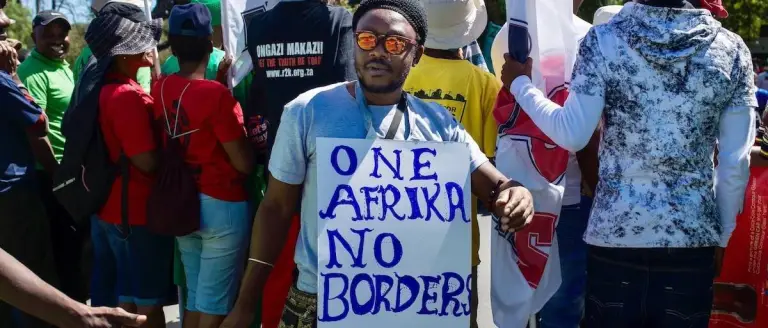Xenophobia and Afrophobia are anchored on two conditions; inferiority complex (poverty of the mind, vision and values) and a subconscious embrace of either White supremacy or tribal supremacy. For self preservation the colonial states created African societies socialised to fear, resent and distrust each other. Paradoxically, the White other is still regarded subconsciously as the better foreigner, saviour and needed ally or friend.
September 2, 2022
Lest we fall into the double jeopardy of conflation of causes of Xenophobia and/or mechanistic finger pointing, let me state unequivocally that each Southern African Development Community (SADC) country leadership and peoples bears the responsibility to ensure that their domestic resources are used for development and their governance is democratic, responsible and accountable. It is indeed selfish and irresponsible to loot one’s country, self-enrich and expect your neighbours to shoulder the consequences of your bad governance, grand corruption and wastage.
That said, it is both a historical and foolish to assume that any of the SADC economies built through migrant labour can survive by adopting xenophobic economic and labour policies. The co-dependencies are just too deep. It is also impossible to understand these co-dependencies abstracted from the history of labour migration in SADC’s political economy. The same could apply in different ways to the Economic Community of West African States (ECOWAS) and the East African Community (EAC).
In fact, in residual colonial settler States of Southern Africa, the distinction between settler and native understood from the last 150 years presents phenomenal challenges. Here is the irony, until recently, white settlers referred to themselves as Europeans and to blacks as Africans. How are 4th-generation settlers less foreign in South Africa than descendents of Mzilikazi’s Ndebele Nation(Ndebele, Sotho, Xhosa,etc), Soshangane (Shangani of Zimbabwe and Mozambique), Zvangendaba(Ngoni of Malawi) or Lewanika (Zambia).
If you are either ignorant of history or consciously deny it, then it is easy to use shoe-string and paper-thin colonial fictions to define something called “Mokwerekwere”. In other words , how is the ancestry of people in Limpopo province or Thohoyandou to be specific separate or different from those in Beitbridge or parts of the historical Rozvi empire? How are folks in Free State wholly and historically different from those in Lesotho?

The socio-economic and political challenges facing SADC countries are immense. Most are the result of failure of leadership and greed, but others are more structural and arise out of history as well as the current global political economy. In solving these myriad of problems, it is important that we eschew simplistic understanding of complex economic realities. It is also important that negative identity politics and short-sighted divisionism does not create longterm cooperation barriers for SADC peoples and economies. Such shortsighted nationalism would be mutually destructive.
You cannot colonise or loot the land and natural resources of a united people or historically divided nation groups that now see you as a common enemy
Tribal and racial identities are forms of villagised security control, supervision and surveillance of the African populations put in place by Apartheid and colonial regimes based on their interest in dividing and conquering native populations. You cannot colonise or loot the land and natural resources of a united people or historically divided nation groups that now see you as a common enemy. Colonial regimes first built mythologised masculine identities anchored on Tribal Trust Lands to which they had either banished or confined Africans whilst stealing their land and cattle. These were severely emasculated men whose cultures had been mutilated to serve the empire. These men were, despite their exploitation by white folks, made to admire ‘whiteness’ and to assert their masculinity in violent and vile terms against other men of different ethno-regional lineage. Whilst promoting a kwashiorkored culture, colonial regimes killed or dethroned guardians of African culture and governance (chiefs, medicine men and women, seers, spirit mediums, etc). In their stead, they created Bantustans and surrogate cultures and chiefs. Bantustans, together with well calculated misinformation and disinformation campaigns became the convenient instrument of divide, conquer and rule policies.
Bantustan mentality is quintessentially anti-global and Xenophobic
White media, occasional and managed interactions between and amongst different ethnic groups from different ethnic groups nourished stereotypes and caricature of each ethno-regional or tribal group. Until the inevitable post World War 2 rapid urbanisation processes as well as the growth of African trade unionism, nationalism and Pan-Africanism, Africans had for 46 years been socialised to fear each other more, to be suspicious, resent and trust each other less than their minority white oppressors. Fear often translated into repeatedly verbalised slurs and sometimes violence against each other. In other words, historical but colonially institutionalised and weaponised-sub-national identities produced vitriolic sub-nationalistic tendencies based on these institutionalised and largely made up Bantustan identities. Bantustan mentality is, therefore, quintessentially anti-global and Xenophobic. The black other is the primary enemy, no matter how poor or equally oppressed. Paradoxically, the white other is, no matter the verbal vilification, still regarded subconsciously as the better foreigner, saviour and needed ally or friend. In essence, in order to sustain Xenophobia towards fellow Black’s (Afrophobia), you require two conditions, namely: inferiority complex (poverty of the mind, vision and values) and a subconscious embrace of either white supremacy or tribal supremacy.
First published in This is Africa

